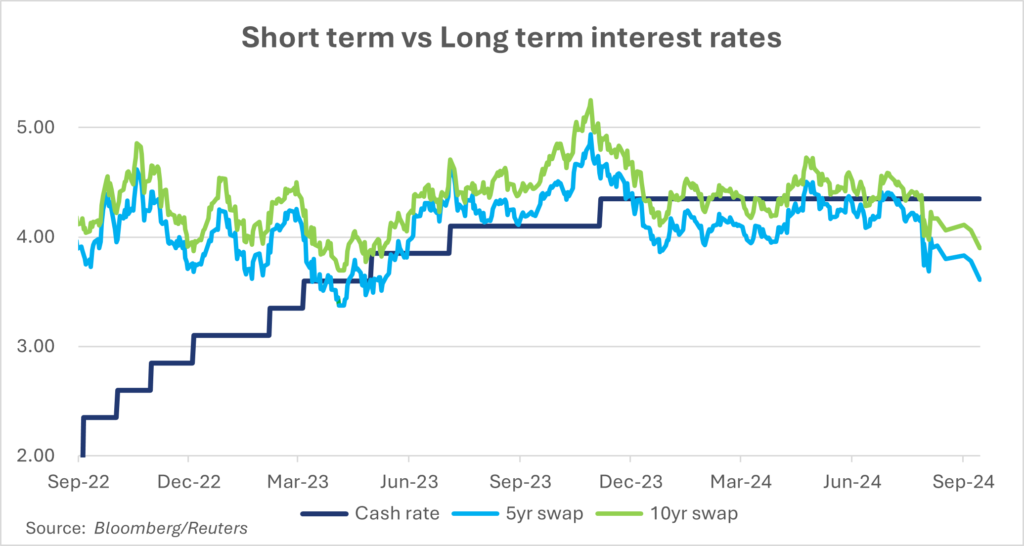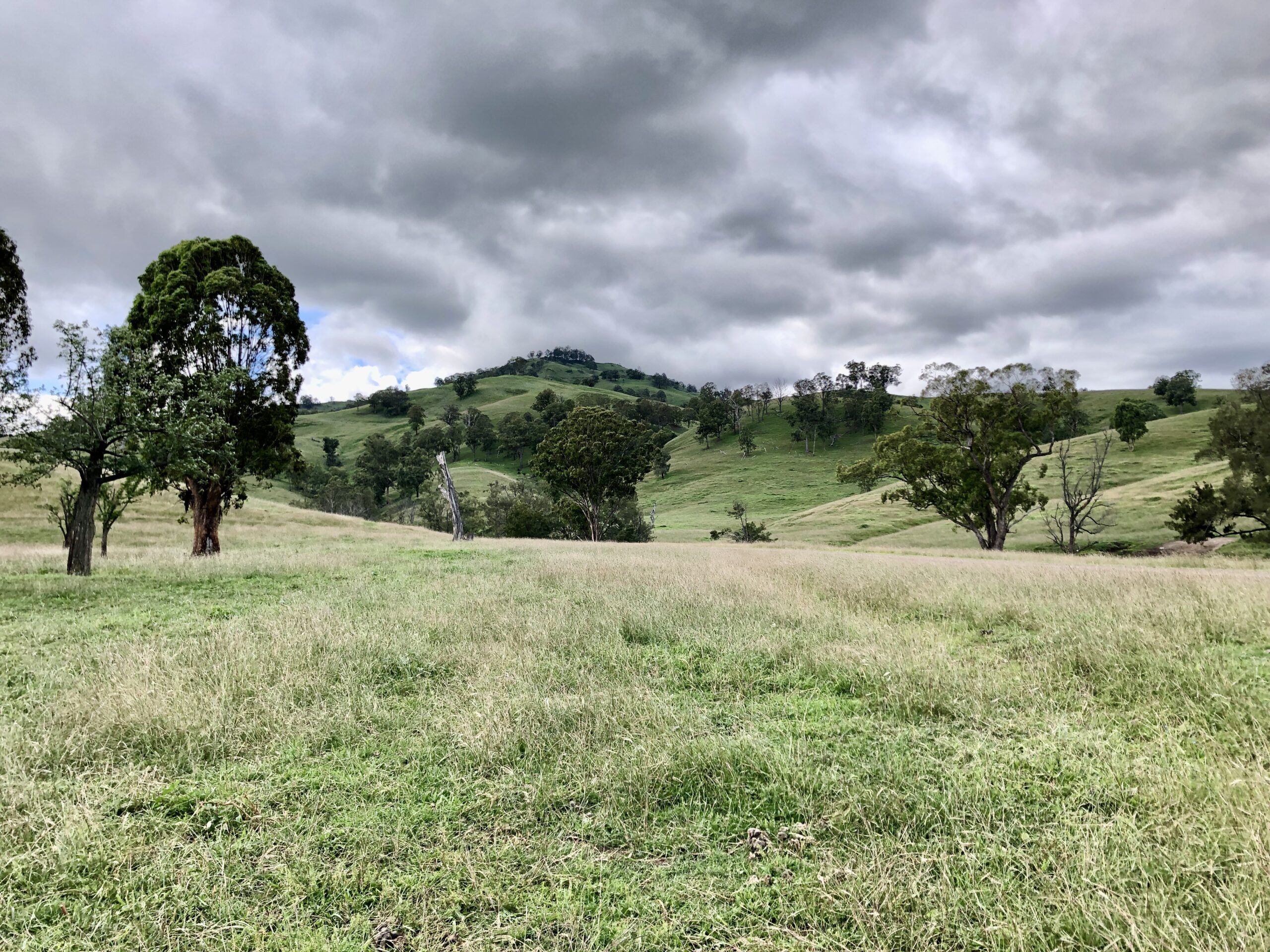Since late 2023, Australia's interest rate yield curve has been inverted, with long-term interest rates cheaper than short-term rates.
Recent concerns about the economic outlook have caused the inversion to steepen and extend further, making longer-term fixed rates more appealing. The current interest rate swap for 5 years is 3.61% and 10 years 3.90%, both sitting well below the RBA cash rate of 4.35%. Borrowers now have an opportunity to lock in historically attractive long-term rates and achieve immediate savings on interest costs.

In Australia inflation remains sticky and there is a risk it will rise in the year ahead, driven by record low unemployment and wage growth above 4%, record government spending, high energy costs, impacts of deglobalisation, etc. This could see the yield curve steepen and there is a high probability the RBA will hold rates at a higher level than expected for a considerable period.
Yield curve inversion
The interest rate yield curve is a key economic indicator of expectations around future economic growth and inflation. Economies are cyclical and move through periods of growth, retraction and then expansion again. In a growing economy, the yield curve typically slopes upward, with long-term interest rates higher than short-term rates. This premium accounts for the greater uncertainty and risks associated with lending over a longer period.
In a slowing economy, the yield curve inverts, sloping downward as short-term rates become higher than long-term rates. Inversion is less common but one of the most reliable indicators of an impending economic downturn. It has historically preceded major recessions, including the early 1990s and the Global Financial Crisis. An inverted curve signals expectations that short-term interest rates will need to remain elevated to curb inflation and slow economic growth before eventually being lowered to stimulate a weakening economy.
Although an inverted yield curve typically signals a recession, there is often a time lag between the inversion and the onset of economic downturn, ranging from a few months to several years. An inversion however doesn’t always lead to a full-blown recession. Sometimes the “Goldilocks” scenario, where economic growth merely slows without triggering a recession, can occur – a situation economists and central bankers dream of.
Like good seasons and high commodity prices, yield curve inversions are temporary, and interest rates eventually return to the more typical upward-sloping curve. The current inversion which first appeared in March 2023 has been prolonged. There was a brief period when the curve reverted to a normal shape, driven by optimism that inflation was only a temporary issue. This optimism faded when the Reserve Bank of Australia (RBA) raised the cash rate by 25 basis points to 4.35% in November 2023. Since then, the inversion has deepened and extended.
Following the RBA’s move, the 5-year interest rate swap, which had been flat with the cash rate, dropped to a peak discount of 0.74% this week. Similarly, the 10-year swap, which was trading at a 0.30% premium to the cash rate prior to the RBA increase, has reached a discount of 0.45%. Interest rates beyond 10 years are now also trading below the cash rate as well (30-year interest rate swap is 3.98%).
Opportunity for borrowers
Farmers generally take a ‘long’ position, basing decisions on long term thinking and convictions, rather than short term market fluctuation. Similarly interest rate strategies should align with a farmer’s long-term financial goals.
During COVID-19, many borrowers deviated from their usual interest rate strategies. Although interest rates hit record lows, the steep yield curve discouraged borrowers from locking in long-term rates. At the time, the premium between the cash rate and the 5-year interest rate swap reached 3.54%, while for 10-year swap it was 3.69%. With shorter-term fixed rates offering a smaller premium, many borrowers opted to lock in rates for just 2-3 years.
The current interest rate yield curve looks more like a rollercoaster ride but with a distinct inverted trend. The RBA has signaled that it does not plan to reduce the cash rate in 2024, and markets remain concerned about stubborn inflation. This is reflected in higher short-term rates, before fears around a slowing economy push longer-term rates lower.

Globally, higher cash rates are starting to cool inflation, and several central banks have begun cutting rates. The US is expected to follow suit in September. This reduction in short-term rates should see their inverted yield curves return to a more normal upward slope.
Australia is an outlier to most developed nations, as it has a relatively low cash rate but higher inflation. Some cracks are appearing in the economy, however the challenge for borrowers is predicting how quickly inflation will fall and short-term rates can be paired back.
If a return to a normal yield curve is expected soon, staying on short-term rates may be a sensible strategy. However, the risk is that inflation persists for longer than expected, and the RBA keeps the cash rate higher for long. In that case, locking in longer-term fixed rates would be beneficial.
Important Disclosure
The information provided IN this DOCUMENT is intended for general information only. It has been prepared and issued by Foundation Agri Finance Pty Ltd ABN 57668249250 which operates under theSA CAPITAL FUNDS MANAGEMENTLIMITED ABN 26123016553 Australian Financial Services Licence 320797as a Corporate Authorised Representative001305527.
This information is general advice.
Foundation Agri Finance Pty Ltd is a specialist arranger of finance to both corporate and private entities or persons. We act for clients who need to have a wholesale, sophisticated or professional accreditation.
In preparing this material, Foundation Agri Finance Pty Ltd nor any of its’ affiliates is, whether by itself or through any agents, making an offer or solicitation, or inviting you to make an offer to subscribe for, purchase or deal in any products specified on the website. Foundation Agri Finance Pty Ltd nor SA Capital Funds Management Limited has not considered your objectives, financial situation or needs. You should consider the appropriateness of any advice before acting on it. You should consider the relevant Product Disclosure Statement terms and conditions, Financial Service Guide, customer information brochure and Guide to Fees and Charges for the product before making any decisions about whether to utilise one of the offered products. Before making a decision on the basis of any documents, the decisionmaker needs to consider whether the advice is appropriate in light of the particular individual needs, objectives and financial circumstances.
Recommendations or opinions expressed may change without notice. Do not act without first consulting your financial adviser to determine whether the product is appropriate for your investment objectives, financial situation, and particular needs. Any prices or quotations contained herein are indicative only and do not constitute an offer to buy or sell any securities at any given price. No representation or warranty, express or implied, is provided in relation to the accuracy, completeness, reliability or appropriateness of the information, methodology and any derived price contained within this material. Past performance is not necessarily indicative of future results. Foundation Agri Finance Pty Ltd nor SA Capital Funds Management Limited, their directors, employees or agents do not accept any liability for any loss or damage arising out of the use of all or any part of these materials. For additional information please contact our office.



